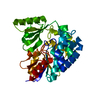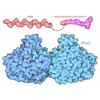+ Open data
Open data
- Basic information
Basic information
| Entry | Database: PDB / ID: 8czc | |||||||||
|---|---|---|---|---|---|---|---|---|---|---|
| Title | AT from first module of the pikromycin synthase | |||||||||
 Components Components | Narbonolide/10-deoxymethynolide synthase PikA1, modules 1 and 2 | |||||||||
 Keywords Keywords | BIOSYNTHETIC PROTEIN / acyltransferase / methylmalonyl-specific / polyketide synthase | |||||||||
| Function / homology |  Function and homology information Function and homology information10-deoxymethynolide synthase / narbonolide synthase / macrolide biosynthetic process / acyltransferase activity, transferring groups other than amino-acyl groups / fatty acid synthase activity / phosphopantetheine binding / 3-oxoacyl-[acyl-carrier-protein] synthase activity / fatty acid biosynthetic process Similarity search - Function | |||||||||
| Biological species |  Streptomyces venezuelae (bacteria) Streptomyces venezuelae (bacteria) | |||||||||
| Method | ELECTRON MICROSCOPY / single particle reconstruction / cryo EM / Resolution: 2.86 Å | |||||||||
 Authors Authors | Keatinge-Clay, A.T. / Dickinson, M.S. / Miyazawa, T. / McCool, R.S. | |||||||||
| Funding support |  United States, 2items United States, 2items
| |||||||||
 Citation Citation |  Journal: Structure / Year: 2022 Journal: Structure / Year: 2022Title: Priming enzymes from the pikromycin synthase reveal how assembly-line ketosynthases catalyze carbon-carbon chemistry. Authors: Miles S Dickinson / Takeshi Miyazawa / Ryan S McCool / Adrian T Keatinge-Clay /  Abstract: The first domain of modular polyketide synthases (PKSs) is most commonly a ketosynthase (KS)-like enzyme, KS, that primes polyketide synthesis. Unlike downstream KSs that fuse α-carboxyacyl groups ...The first domain of modular polyketide synthases (PKSs) is most commonly a ketosynthase (KS)-like enzyme, KS, that primes polyketide synthesis. Unlike downstream KSs that fuse α-carboxyacyl groups to growing polyketide chains, it performs an extension-decoupled decarboxylation of these groups to generate primer units. When Pik127, a model triketide synthase constructed from modules of the pikromycin synthase, was studied by cryoelectron microscopy (cryo-EM), the dimeric didomain comprised of KS and the neighboring methylmalonyl-selective acyltransferase (AT) dominated the class averages and yielded structures at 2.5- and 2.8-Å resolution, respectively. Comparisons with ketosynthases complexed with their substrates revealed the conformation of the (2S)-methylmalonyl-S-phosphopantetheinyl portion of KS and KS substrates prior to decarboxylation. Point mutants of Pik127 probed the roles of residues in the KS active site, while an AT-swapped version of Pik127 demonstrated that KS can also decarboxylate malonyl groups. Mechanisms for how KS and KS domains catalyze carbon-carbon chemistry are proposed. | |||||||||
| History |
|
- Structure visualization
Structure visualization
| Structure viewer | Molecule:  Molmil Molmil Jmol/JSmol Jmol/JSmol |
|---|
- Downloads & links
Downloads & links
- Download
Download
| PDBx/mmCIF format |  8czc.cif.gz 8czc.cif.gz | 64 KB | Display |  PDBx/mmCIF format PDBx/mmCIF format |
|---|---|---|---|---|
| PDB format |  pdb8czc.ent.gz pdb8czc.ent.gz | 45.9 KB | Display |  PDB format PDB format |
| PDBx/mmJSON format |  8czc.json.gz 8czc.json.gz | Tree view |  PDBx/mmJSON format PDBx/mmJSON format | |
| Others |  Other downloads Other downloads |
-Validation report
| Summary document |  8czc_validation.pdf.gz 8czc_validation.pdf.gz | 1.1 MB | Display |  wwPDB validaton report wwPDB validaton report |
|---|---|---|---|---|
| Full document |  8czc_full_validation.pdf.gz 8czc_full_validation.pdf.gz | 1.1 MB | Display | |
| Data in XML |  8czc_validation.xml.gz 8czc_validation.xml.gz | 26.6 KB | Display | |
| Data in CIF |  8czc_validation.cif.gz 8czc_validation.cif.gz | 35.7 KB | Display | |
| Arichive directory |  https://data.pdbj.org/pub/pdb/validation_reports/cz/8czc https://data.pdbj.org/pub/pdb/validation_reports/cz/8czc ftp://data.pdbj.org/pub/pdb/validation_reports/cz/8czc ftp://data.pdbj.org/pub/pdb/validation_reports/cz/8czc | HTTPS FTP |
-Related structure data
| Related structure data |  27094MC  7uwrC C: citing same article ( M: map data used to model this data |
|---|---|
| Similar structure data | Similarity search - Function & homology  F&H Search F&H Search |
- Links
Links
- Assembly
Assembly
| Deposited unit | 
|
|---|---|
| 1 |
|
- Components
Components
| #1: Protein | Mass: 33011.234 Da / Num. of mol.: 1 Source method: isolated from a genetically manipulated source Details: First AT domain of pikromycin synthase / Source: (gene. exp.)  Streptomyces venezuelae (bacteria) / Gene: pikAI / Production host: Streptomyces venezuelae (bacteria) / Gene: pikAI / Production host:  References: UniProt: Q9ZGI5, 10-deoxymethynolide synthase, narbonolide synthase |
|---|
-Experimental details
-Experiment
| Experiment | Method: ELECTRON MICROSCOPY |
|---|---|
| EM experiment | Aggregation state: PARTICLE / 3D reconstruction method: single particle reconstruction |
- Sample preparation
Sample preparation
| Component | Name: Pik127 / Type: COMPLEX Details: Polyketide synthase engineered from the first, second, and seventh modules of the pikromycin synthase as described in Miyazawa et al., 2021, Chem. Commun. 57:8762-8765 Entity ID: all / Source: RECOMBINANT | |||||||||||||||||||||||||
|---|---|---|---|---|---|---|---|---|---|---|---|---|---|---|---|---|---|---|---|---|---|---|---|---|---|---|
| Molecular weight | Value: 0.41 MDa / Experimental value: NO | |||||||||||||||||||||||||
| Source (natural) | Organism:  Streptomyces venezuelae (bacteria) / Strain: 15439 Streptomyces venezuelae (bacteria) / Strain: 15439 | |||||||||||||||||||||||||
| Source (recombinant) | Organism:  | |||||||||||||||||||||||||
| Buffer solution | pH: 7.5 Details: Buffer was made fresh because TCEP rapidly degrades in phosphate | |||||||||||||||||||||||||
| Buffer component |
| |||||||||||||||||||||||||
| Specimen | Conc.: 1.5 mg/ml / Embedding applied: NO / Shadowing applied: NO / Staining applied: NO / Vitrification applied: YES Details: This sample was monodisperse. It was incubated with its substrates, methylmalonyl-CoA and NADPH, for 30 min. at 25 C before freezing. | |||||||||||||||||||||||||
| Specimen support | Grid material: COPPER / Grid mesh size: 200 divisions/in. / Grid type: C-flat-2/2 | |||||||||||||||||||||||||
| Vitrification | Instrument: FEI VITROBOT MARK IV / Cryogen name: ETHANE / Humidity: 100 % / Chamber temperature: 277.15 K Details: Blotted for 3 seconds with a force of "1" before plunging. |
- Electron microscopy imaging
Electron microscopy imaging
| Experimental equipment |  Model: Titan Krios / Image courtesy: FEI Company |
|---|---|
| Microscopy | Model: FEI TITAN KRIOS Details: Collected 4284 movies at 0 degrees tilt and 2912 movies at -30 degrees tilt |
| Electron gun | Electron source:  FIELD EMISSION GUN / Accelerating voltage: 300 kV / Illumination mode: FLOOD BEAM FIELD EMISSION GUN / Accelerating voltage: 300 kV / Illumination mode: FLOOD BEAM |
| Electron lens | Mode: BRIGHT FIELD / Calibrated magnification: 61728 X / Nominal defocus max: 1500 nm / Nominal defocus min: 800 nm / Cs: 2.7 mm / C2 aperture diameter: 70 µm / Alignment procedure: ZEMLIN TABLEAU |
| Specimen holder | Cryogen: NITROGEN / Specimen holder model: FEI TITAN KRIOS AUTOGRID HOLDER |
| Image recording | Average exposure time: 5 sec. / Electron dose: 70 e/Å2 / Detector mode: COUNTING / Film or detector model: GATAN K3 (6k x 4k) / Num. of grids imaged: 1 / Num. of real images: 7196 / Details: 20 frames per second |
| Image scans | Movie frames/image: 100 |
- Processing
Processing
| EM software |
| ||||||||||||||||||||||||||||||||||||||||||||
|---|---|---|---|---|---|---|---|---|---|---|---|---|---|---|---|---|---|---|---|---|---|---|---|---|---|---|---|---|---|---|---|---|---|---|---|---|---|---|---|---|---|---|---|---|---|
| CTF correction | Details: CTF correction performed by cryosparc during reconstruction Type: PHASE FLIPPING AND AMPLITUDE CORRECTION | ||||||||||||||||||||||||||||||||||||||||||||
| Particle selection | Num. of particles selected: 6761206 Details: From blob picker, 6,761,206 particles were selected. Then, from template picker, 2,350,020 particles were selected. | ||||||||||||||||||||||||||||||||||||||||||||
| Symmetry | Point symmetry: C1 (asymmetric) | ||||||||||||||||||||||||||||||||||||||||||||
| 3D reconstruction | Resolution: 2.86 Å / Resolution method: FSC 0.143 CUT-OFF / Num. of particles: 184737 Details: Maps were density modified using Phenix to a calculated resolution of 2.77 Angstroms. Num. of class averages: 1 / Symmetry type: POINT | ||||||||||||||||||||||||||||||||||||||||||||
| Atomic model building | Protocol: FLEXIBLE FIT / Space: REAL / Target criteria: Phenix | ||||||||||||||||||||||||||||||||||||||||||||
| Atomic model building | PDB-ID: 2QO3 Accession code: 2QO3 / Source name: PDB / Type: experimental model |
 Movie
Movie Controller
Controller




 PDBj
PDBj



